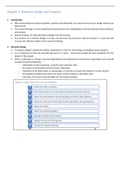Chapter 5: Research Design and Proposal
1. Introduction
After formulating the research problem, question and objectives, the research structure or design needs to be
determined.
The research design is a plan indicating the required data, the sampling plan and the methods of data collection
and analysis.
Research design can help eliminate mistakes and inaccuracies.
The purpose of a research design is to plan and structure the particular research project in a way that will
increase the ultimate validity of the research findings.
2. Research Design
A research design is simply the outline, framework, or plan for conducting a marketing research project.
It is a statement of only the essential elements of a study – those that provide the basic guidelines for the
details of the project.
What is contained in a design may vary depending on the preference of the person responsible, but it should
include at least the following:
- Information on the researcher, research team and their skills.
- the nature of the problem and the study’s objectives.
- statement of the data inputs, or causal data, on the basis of which the solution is to be reached.
- the analytical method with which the inputs will be treated or calculated; and
- resources, time and money available for the research project.
, 3. Research Objective Classification
Research Objectives are classified according to fundamental objectives of the research into conclusive and
exploratory research design
- Exploratory Research Design
- Conclusive Research Design
Descriptive Research
Causal Research
Exploratory research Design → secondary research
Exploratory studies are intended to explore a relatively unknown area. Exploratory research necessary when
more information and insight is required regarding a problem, opportunity, phenomenon, and especially to
collect data that can contribute to more meaningful research questions.
The objectives of an exploratory study are:
- To acquire new insight into the phenomenon
- To be a preliminary survey before a more structured study.
- To explain central concepts and constructs
- To determine priorities for further research.
- To develop new hypotheses about an existing phenomenon.
The objective of an exploratory study is to acquire insight and develop understanding, rather than to collect
accurate replicable data.
Methods for conducting exploratory research are:
- Literature surveys: a survey of existing relevant literature in libraries, via the internet and commercial
databases.
- Case studies: an analysis of examples or cases of the phenomenon that stimulates insight.
- Pilot studies: information collected from the actual subjects of the research project. The most
common categories of pilot studies are focus groups, interactive media and online research, projective
techniques and in-depth interview.
Conclusive Research Design
Conclusive design is the deign that helps the researcher study the research problem in a conclusive form, and
then to choose a possible course of action from various alternatives.
Descriptive Studies
- Descriptive studies are a statistical method used to identify patterns or trends in a situation.
Descriptive research can describe opportunities or threats, and answer the questions: who, what,
when, and where.
- Descriptive research is based on a measure of previous understanding of the nature of the research
problem, but the conclusive evidence necessary to answer questions and determine a course of action
has yet to be collected.
- Objective of descriptive research is to describe the research domain accurately and thoroughly.
- Methods of Descriptive Studies:
Longitudinal studies: Also known as timeseries studies and involve a repetitive measurement
of the same sample elements over time. There are two types of longitudinal studies:
continuous or true panels and
discontinuous or omnibus panels.
Crosssectional studies: Involves collecting information from any given sample of population
just once.
Two characteristics that distinguish crosssectional studies from longitudinal studies are that,
in cross sectional studies:
A snapshot of the variable concerned is provided at a given point in time, and
The sample of elements is representative of the target population.
Casual studies
- Descriptive research reveals possible links between variables, while causal research either confirms
and describes the relationship, or shows it to be false.




